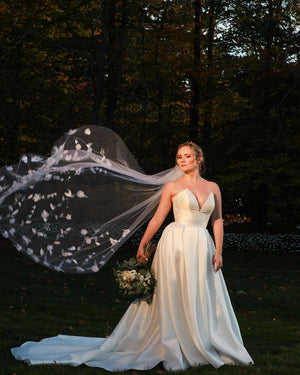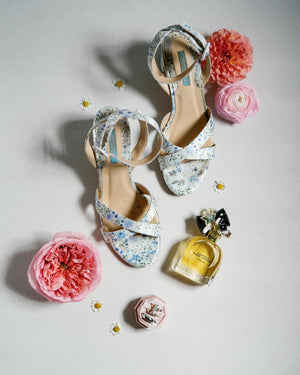You may also like
In the intricate world of wedding planning, each decision feels momentous, and the wedding veil is among the most iconic elements. Wedding veils have held a place in bridal fashion for centuries, symbolizing purity, modesty, and elegance. Yet, as bridal trends have evolved, so has the range of wedding veil styles, fabrics, and embellishments, which can lead brides to wonder: How much should you really expect to spend on a wedding veil?
This guide breaks down all the factors that influence wedding veil pricing, giving you a clear view of what to expect when shopping for that special piece to complement your dress and complete your bridal look.
Understanding the Basics: Types of Wedding Veils
Before diving into pricing specifics, it's helpful to know a bit about the different types of wedding veils. Each veil style can vary in both cost and aesthetic, giving you a unique look that reflects your personal style and wedding vision. Here’s a breakdown of popular veil types and their average price ranges:
- Birdcage Veil: This short veil usually covers the face and is often made of netting or tulle. It adds a vintage flair and is typically less expensive, ranging from $30 to $200.
- Elbow-Length Veil: This style reaches the elbows and works well with many dress styles. Expect to pay between $100 and $400.
- Fingertip Veil: A popular choice for brides, this veil falls to the fingertips and can feature intricate details. Prices range from $150 to $600.
- Chapel Veil: This wedding veil is longer than the elbow-length option, typically extending to the floor and cascading behind you. You can find them priced from $200 to $800, depending on the materials and details.
- Cathedral Veil: For a dramatic look, cathedral veils extend several feet past the bride’s train. Due to the extra fabric and craftsmanship involved, these can range from $300 to over $1,500.
- Mantilla Veil: A Spanish-style veil, this lace-edged option can be a bit pricier, typically starting at $200 and going up to $1,000 or more depending on length and materials.


Bride: Jaci Jamieson, LA, USA - Photo: peonyphotography. Veil: Kaitie
Factors Influencing the Cost of Wedding Veils
Now that you know the different types of veils let’s explore the factors that can affect the overall price.
- Material: The fabric used for the veil plays a significant role in its cost. Common materials include:
- Tulle: Lightweight, airy, and the most budget-friendly choice. Tulle veils are perfect for adding soft, ethereal volume.
- Silk: Luxurious and with a natural sheen, silk is often pricier but lends an unparalleled elegance.
- Lace: Whether as an edge or covering the entire veil, lace is beautiful for adding intricate detail on top of other materials, but can increase the cost, especially if it’s handmade.
- Organza: A stiffer fabric that provides structure, which can vary in price depending on the quality. Get to know more about Wedding Veil Fabrics.
- Length: A veil’s length significantly affects its cost. Longer veils require more fabric and craftsmanship, naturally increasing the price. While fingertip veils are more moderate, cathedral-length veils that extend several feet beyond the dress generally come at a premium due to the added material and work involved.
- Design and Embellishments: A simple, unadorned veil will naturally be more affordable than one adorned with crystals, beads, or lace appliqués. However, for brides seeking a truly unique and personalized touch, a veil with colorful floral design can be a stunning investment that elevates their bridal look. Custom designs and personalizations can also increase the cost significantly due to the labor involved in creating a new and unique design, followed by handcrafting the veil itself.



- Brand: High-end bridal designers typically charge more for their veils due to their reputation. However, many affordable options are available from lesser-known brands and artists that offer beautiful designs without the designer price tag.
- Retailer: Where you purchase your veil matters. Bridal boutiques often charge more than online retailers, where you may find more competitive prices. Consider shopping around and comparing prices to find the best deal.
- Custom vs. Ready-Made: If you’re envisioning a specific veil style or have unique requirements, a custom veil may be the perfect solution. Custom veils are often crafted to your exact preferences, but they can be more expensive than ready-made options, typically ranging from $300 to $1,500, depending on the materials and complexity.
Average Costs: What Brides Are Spending
So, how much do brides actually spend on wedding veils? Based on recent surveys and anecdotal evidence, here’s a general breakdown of what to expect:
- Budget-Friendly Veils: These veils are usually priced between $30 and $150. They may be ready-made from basic materials but still look lovely for a wedding.
- Mid-Range Veils: Most brides fall into this category, spending between $150 and $600. This range often includes beautiful designs with moderate embellishments and quality materials.
- High-End Veils: For those wanting to make a statement, spending $600 and up is common. High-End veils can include elaborate designs, high-quality fabrics, and custom options.
Where to Buy Your Wedding Veil
Knowing where to purchase your veil can significantly influence your budget. Here are a few options to consider:
- Bridal Boutiques: These shops often carry a curated selection of veils, providing personalized service. However, prices can be on the higher side.
- Online Retailers: Websites like Etsy, Amazon, and specialized bridal shops often offer a wide range of options at various price points. Shopping online can be a convenient way to compare prices.
- Department Stores: Some department stores have bridal sections with affordable ready-made veils. This option can be a great way to find a stylish veil without breaking the bank.
- Custom Designers: If you have a specific vision, working with a designer for a custom bespoke wedding veil is the best choice. Just be prepared for a higher price point.
- Sample Sales: Keep an eye out for bridal sample sales at boutiques, where you can snag high-quality veils at reduced prices.
Check out our blog "Where to Buy the Perfect Veil: Top Stores for Every Budget" for more information
Tips for Budgeting for Your Wedding Veil
If you’re concerned about the cost of your wedding veil, here are some tips to help you budget effectively:
- Set a Realistic Budget: Determine how much you’re willing to spend on your veil before you start shopping. This will help you narrow down your options and avoid overspending.
- Prioritize: Consider how important the veil is to your overall wedding look. If it’s a significant part of your vision, be prepared to invest a little more.
- Shop Off-Season: If your wedding date isn’t set in stone, consider planning it during the off-season (typically late fall to early spring). Many retailers offer discounts during this time.
- Look for Discounts: Keep an eye out for sales, promotions, or coupon codes online. Joining mailing lists for bridal shops can also alert you to upcoming sales.
- Don’t Forget Alterations: If you buy a veil that needs adjustments, budget for alteration costs, which can range from $20 to $100.
Final Thoughts: Finding the Perfect Veil
Choosing your wedding veil is a significant aspect of your bridal look, and being aware of the costs involved will help you navigate your shopping experience with confidence. Finding the perfect wedding veil for your bridal hairdo will influence your budget decisions. By keeping in mind factors such as style, material, and where you shop, you can discover a stunning veil that aligns with both your budget and your vision for your wedding day.
If you have any questions about pricing or need guidance on selecting the perfect wedding veil, feel free to contact us at Tara Bridal. Remember, this is something special, so take your time, do your research, and enjoy the journey of finding the ideal veil that will beautifully complete your bridal ensemble.








